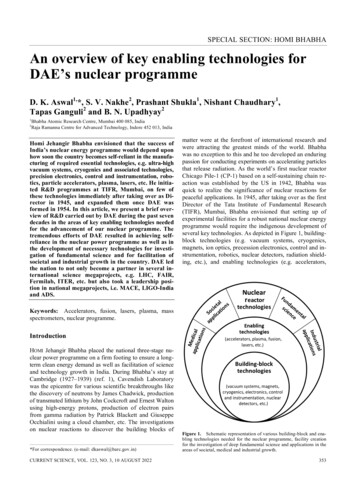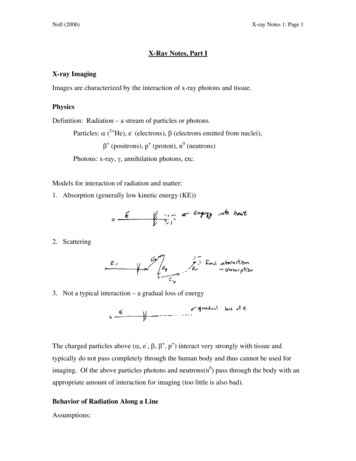
Transcription
Institutionen för medicin och vårdAvdelningen för radiofysikHälsouniversitetetBasic physics of X-ray imagingCarl A Carlsson and Gudrun Alm CarlssonDepartment of Medicine and CareRadio PhysicsFaculty of Health Sciences
Series: Report / Linköpings högskola, Institutionen för radiologi; 8ISRN: LIU-RAD-R-008Second edition 1996 The Author(s)
Basic physics of X-ray imagingCarl A Carlsson and Gudrun Alm CarlssonDepartment of Radiation PhysicsFaculty of Health SciencesLinköping universitySwedenREPORTLiH-RAD-R-008Second edition 1996
TABLE OF CONTENTS1. Introduction . 32. The physics of the X-ray source: the X-ray tube . 33. The energy spectrum of X-rays . 74. The interactions of X-rays with matter . 125. Contrast . 196. Energy absorption of X-rays . 227. Stochastics in the X-ray image . 278. Appendix . 289. References . 292
Basic physics of X-ray imaging1. INTRODUCTIONIn X-ray diagnostics, radiation that is partly transmitted through and partly absorbed inthe irradiated object is utilised. An X-ray image shows the variations in transmissioncaused by structures in the object of varying thickness, density or atomic composition. InFigure 1, the necessary attributes for X-ray imaging are shown: X-ray source, object(patient) and a radiation detector (image receptor).Figure 1. The necessary attributes for X-ray imaging: X ray source, object (patient) andradiation detectorAfter an introductory description of the nature of X-rays, the most important processes inthe X-ray source, the object (patient) and radiation detector for the generation of an X-rayimage will be described.2. THE PHYSICS OF THE X-RAY SOURCE: THE X-RAY TUBEa. The nature of X-raysX-rays are like radio waves and visible light electromagnetic radiation. X-rays, however,have higher frequency, ν , and shorter wavelength, λ, than light and radio waves. Theradiation can be considered as emitted in quanta, photons, each quantum having a welldefined energy, hν , where h is a physical constant, Plancks constant, and ν is thefrequency. The energy of X-ray photons are considerably higher than those of light.A number of the phenomena, which are observed with X-rays are most convenientlydescribed by the wave properties of the radiation while other phenomena can be moreeasily understood if the X-rays are considered as being composed of particles (photons)with well defined energies and momentum. The rest mass of a photon is zero. This meansthat photons can never be found at rest. All photons move at the same velocity, c, in avacuum, given by c 2.998 108 m/s.b. Relationship between wave length and frequency3
The wave length multiplied with the frequency (number of wave lengths per unit time)equals the velocity of lightλ ν c(1)c. The propagation of X-raysSimilarly to visible light, X-rays propagate linearly. The rays from a point source form adivergent beam. The number of photons passing per unit area perpendicular to thedirection of motion of the photons is called the fluence, Φ . The fluence in a vacuumdecreases following the inverse square law, given byΦ (r) Φ (1) 1r2(2)where r is the distance from the point source and Φ (1) is the fluence at r 1 (relativeunits).The inverse square law is illustrated in Fig 2.Figure 2. The fluence, Φ , of X-rays decreases with the square of the distance from thesource.d. Refraction of X-raysWhen visible light passes from one medium to another it is refracted due to the differentvelocities of the rays in different media and interference of waves. The velocity ofpropagation of X-rays varies much less in different materials and the refraction of X-raysis negligible. For this reason, X-rays cannot be focussed be means of lenses.4
e. Diffraction of X-raysAnother wave phenomenon is diffraction. This means that the wave can be bent whenpassing an edge or a slit. The slit can then be regarded as a new source of wavespropagating in all directions. If there is a periodic system of slits (lattice), interferenceeffects will occur. That is, waves which are in phase will be amplified and those that areout of phase will be weakened. In order to demonstrate diffraction with X-rays the latticeconstant (distance between the scattering slits) must be of the order of 0.1 nm. Suchdistances exist between the atomic planes in crystals. Crystals are frequently used for Xray spectrometry.f. Generation of X-raysAn X-ray tube consists of two electrodes, one negative, glow cathode, which upon beingheated emits electrons, and one positive, anode. The electrodes are incapsuled in avacuum. By applying an acceleration potential (20-200 kV), the electrons are acceleratedtowards the anode. The electrons gain kinetic energy which is the product of their chargeand the potential difference. As a measure of the kinetic energy of the electrons and X-rayphotons, the unit of 1 eV is used.Definition: One electron volt (1 eV) is the kinetic energy, that a charged particle of oneelementary charge (the charge of an electron) achieves when being accelerated in apotetial difference of one volt (1 V); 1 eV 1.602 10 19 J (joule). See Fig 3.Figure 3. One electron volt (1 eV) is the kinetic energy of an electron which has beenaccelerated through a potetial difference of 1 volt.If the potential difference is 100 kV, each electron gets a kinetic enegy of 100 keV (1000ev 1 keV).When the elcetron reaches the anode it imparts the main part of its energy to the atoms ofthe anode by ionisations and excitations. This energy will finally appear as heat energy.If an electron passes close to an atomic nucleus, it will change its direction of motion,i.e., exhibits an acceleration. At each such acceleration there is a small probability that5
the electron looses energy in the form of a photon, Fig 4. These photons are calledbremsstrahlung photons and constitute the main part of the X-rays being used in X-raydiagnostic imaging.Figure 4. Bremsstrahlung is generated when an electron with high energy changes itsdirection of motion in the neighbourhood of an atomic nucleus and thereby looses energy.The bremsstrahlung photon can obtain an arbitrary energy between zero and the whole ofthe kinetic energy of the electron, T.hνmax T(3)The relative amount of bremsstrahlung emitted increases with incresing electron kineticenergy and with increasing atomic number, Z, of the anode material.Since the major part of the energy of the electrons is converted into heat in the anode(about 1% will appear as X-rays), the anode material should have a high melting pointand good heat conduction ability. To get a high relative amount of X-ray energy, theanode material should be of high atomic number. Tungsten is the dominating anodematerial and is in modern X-ray tubes often mixed with renium (ZW 74; ZRe 75).Modern X-ray imaging requires a small focal spot and high X-ray fluence rates (numberof photons per unit area and unit time). To meet these requirements, technical solutionswith a line shaped focal spot and rotating anode have been introduced.3. THE ENERGY SPECTRUM OF X-RAYSa. Dependence of the energy spectrum on tube potential6
Fig 5 shows energy spectra from an X-ray tube, the glass envelope of which gives afiltration corresponding to 2 mm Al (aluminium). The X-rays are then additionallyfiltered by an extra layer of 1 mm Al. The energy spectra show the number of photons perunit energy interval, (keV), emitted within a unit interval of the solid angle, (steradian),when the charge 1 mAs passes through the X-ray tube. The energy spectra have beenmeasured at constant acceleration potential differences of 40, 70, 100 and 130 kV (Mikaand Reiss 1969). As can be seen from Fig 5, there are only few photons close to themaximum energy.Figure 5. Energy spectra of X-rays at different (constant) acceleration potentialdifferences (Mika and Reiss 1969). Total filtration. 3 mm AlThe number of X-rays emitted in the anode per unit energy interval increases withdecreasing energy. The attenuation of the photons in the anode itself, the glass envelopeand additional filter increases, however, still more with decreasing energy such that thenumber of low energy photons is heavily reduced. There are practically no photons withenergies less than 10 keV, which are emitted from an X-ray tube with the abovementioned filters (Fig 5).The sharp peaks shown in the energy spectra at 100 and 130 kV acceleration potentialdifferences (Fig 5) are characteristic Kα and Kβ photons from tungsten.Characteristic roentgen rays (fluorescence radiation) are emitted when a vacancy in anelectron shell (here the K-shell) is filled with an electron from an outer shell. The emittedenergy equals the difference in binding energy of the electron in the two shells. Vacanciesin the K-shell can result from either ionisations caused by the accelerated electrons orfrom photoelectric absorption of bremsstrahlung photons (with energies higher than thebinding energy of the electrons in the K shell) in the anode itself. In order to ionise the Kshell of tungsten an energy of 69.5 keV is needed. For characteristic K-photons to beemitted, the acceleration potential difference must exceed 70 kV.7
From Fig 5 it can be seen that the relative proportion of characteristic K-radiationincreases with incresing tube potential. This means that the imaging properties of the Xrays is only slowly varying with variations in the tube potential at tube potentials above130 kV. Fig 5 shows how the number of photons varies at constant value of the tubecharge (mAs-value the product of tube current, mA and exposure time, s).If instead the acceleration potential difference is kept constant and the charge through theX-ray tube (mAs) is increased, the shape of the energy spectrum remains the same, i.e.,the relationship between the number of photons in the different energy intervals. Thenumber of photons in each interval is proportional to the mAs-value.b. Variation of the energy spectrum with filteringFig 6 shows the energy spectrum of photons from an X-ray tube with a beryllium window(Drexler and Perzl 1967). The beryllium (atomic number Z 4) window transmits muchmore low energy photons than the glass envelope. In the energy spectrum characteristicL-photons can be seen with energies around 9.5 keV. The low energy photons shouldnormally be avoided since they do not penetrate fairly thick objects, i.e.,they do notcontribute to the image formation but only to the energy deposition in the patient. Asadditional filters (Fig 6), sheets of 1, 2 and 4 mm of aluminium (Al) and 0.1 mm ofcopper (Cu) have been used.The thin (0.1 mm) sheet of copper filters the X-rays as effectively as 3.5 mm Al at 20keV, as 2 mm Al at 60 keV and as 1 mm Al at 95 keV.Figure 6. Energy spectra of X-rays with different filtrations. X-ray tube with a berylliumwindow. Filter: 0, 1, 2 and 4 mm aluminium and 0.1 mm copper.8
c. Variation of the energy spectrum with tube potential pulsationsThe energy spectra shown in Figs 5 and 6 are valid in cases when the tube potential doesnot vary with time. In practice, alternating potentials derived from the electricity net (50Hz, 220 V) are used and transformed to higher potentials.The number of pulses per alternating current period is, with the simplest constructions, 1or 2, with tubes of high quality 6 or 12 (Fig 7).Figure 7. Tube potential variations (ripple) at 2, 6 and 12 pulses per alternating currentperiod.Wirh 12 pulses per period, the tube potential is very close to constant with time and theenergy spectra in Figs 5 and 6 are valid. Figure 8 shows two energy spectra with peakpotentials of 100 kV.Figure 8. The upper spectrum is valid at constant tube potential, the lower at a sinusoidalvariation of the potential (see 2-pulse, Fig 7). The figure above the energy spectra showsthat the potential pulsations in particular reduces the number of high energy photons inthe spectrum.9
Long cables or capacitances can counterbalance the fluctuations. The effect of this ismost pronounced for 1- or 2 pulse generators at low tube currents (mA).From Fig 8 it can be seen that increased potential variations (ripple) reduces the numberof emitted X-ray photons per mAs and that the reduction is particularly high for the highenergy photons. For instance, the number of photons obtained with a sinusoidal potentialvariation, relative to the number obtained at constant potential, is 20% at 90 keV and65% at 20 keV.d. Variation of the energy spectrum with the direction of emissionThe anode of the X-ray tube in most cases forms an acute angle with respect to thedirection of emission of the X-rays used for imaging. The X-rays emitted at acute anglesto the anode plate are filtered in the anode. As a consequence, the number of photonsdecreases with decreasing angle between the anode plate and the direction of emission,this being more pronounced the lower the photon energies. The effect is called the heeleffect and is most pronounced for small anode angles and increases in old X-ray tubes asa result of a rugged anode surface, Fig 9.Figure 9. The heel effect. The left figure shows how the "amount of X-rays" is decreasedon the anode side (here measured i terms of the air kerma (exposure)). The right figureshows how the "mean energy" of the photons (measured in terms of the ability topenetrate through aluminium (half value thickness HVT) increases on the anode side.10
The energy spectrum of the photons in different emission angles is shown in Fig 10 at120 kV tube potential.Figure 10. Fluence energy spectra obtained at 120 kV tube potential in differentdirections (α) of emission relative to the anode surface. The central ray corresponds toα 15 . The peaks of the characteristic radiation are not fully illustrated but relativevalues of the photon fluence rate of the peaks, including the continuous distribution, aregiven in the table (Svahn 1977).11
4. THE INTERACTIONS OF X-RAYS WITH MATTERa. Attenuation of photonsThere are principally two interaction processes that give rise to the variation in photontransmission through the patient which is the basis of X-ray imaging. These arephotoelectric absorption and scattering. The scattering is of two kinds: incoherent(Compton) scattering and coherent scattering. (At photon energies above 1 MeV, pairproduction is also possible. Such high photon energies are, however, not used inconventional X-ray diagnostics.)A photon which has experienced an interaction process is lost as primary radiation: it haseither been absorbed or has changed its energy and/or direction of motion. A photon thatchanges its direction of motion is called a scattered photon.For monoenergetic photons, the number of photons removed from the primary beamwhen this is incident on a thin layer of material is proportional to the number of incidentphotons (N) and the thicness of the layer (dx), Fig 10.dN µNdx(4)where µ is a constant of proportionality called the linear attenuation coefficient.The linear attenuation coefficient, µ, is the probability, p, per unit length, x, for a photonof given energy to interact in passing through a given medium.µ dpdx(5)Figure 11. Attenuation of monoenergetic photons in a thin layer of a given material12
The different interaction processes add their contributions to the total linear attenuationcoefficient µµ τ σcoh σincoh κ .(6)where τ , σcoh , σincoh and κ are the contributionsto the attenuation from photoelectricabsorption, coherent scattering, incoherent scattering and pair production.The solution to the differential equation, Eq(4), isN(x) N(0) e µx(7)From Eq(7), it is seen that the primary photons are attenuated exponentially with thepenetration depth x.b. Photoelectric absorptionIn this process, the photon is absorbed and an electron (photoelctron) is emitted from theatomic shell with kinetic energy, TT hν Bi(8)where Bi is the binding energy of the electron in atomic shell i. In Fig 12, the process isshown schematically.As a result of the photoelectric absorption, a vacancy is created in the atomic shell. Whenthis vacancy is filled with an electron from an outer shell, energy is liberatedcorresponding to the difference in the binding energies of the inner and outer shells. Thisenergy is emitted either in the form of a photon, characteristic roentgen radiation(fluorescence radiation) or is transferred to an electron in an outer shell. This electron isemitted from the shell and is called an Auger electron. The probability for emission ofcharacteristic roentgen radiation subsequent to a photoelectric absorption increases withincreasing atomic number and is largest for vacancies in the K-shell. The fluorecsenceyield increases with increasing binding energy of the photoelectron.NucleusFigure 12. Photoelectric absorption and subsequent deexcitation of the atomic shell13
The emission of characteristic roentgen rays (and Auger electrons) is isotropic (equalprobability for all directions of motion). It occurs with no memory of the direction ofmotion of the absorbed photon.The probability per unit length, τ , for photoelectric absorption decreases with increasingphoton energy until an absorption edge is reached. In passing the absorption edge, moreelectrons are available for absorption and the probability of the process increasesdramatically. In passing the K-edge (the innermost shell), the probability of photoelectricabsorption increases with a factor of 4-14, higher factors for lower atomic numbers. InFig 13, the probability for photoelectric absorption is shown for iodine (Z 53). Here, themass attenuation coefficient, µ / ρ is given, i.e., the linear attenuation coefficient dividedby the density of the material.Figure 13. The contribution from photoelectric absorption, τ / ρ , to the mass attenuationcoefficient for iodine as a function of photon energyIn Fig 14 , values of τ / ρ are shown for a number of different materials.Figure 14. The dependence of the photoelectric absorption on photon energy, hν , andatomic number, Z.14
c. Incoherent scattering (Compton process)At an incoherent scattering, a photon collides with an atomic electron, Fig 15. The photonis scattered with reduced energy. The electron receives the kinetic energy T hν hν′,where hν is the energy of the incident photon and hν ′is that of the scattered photon.Figure 15. The Compton processA simple relationship (the Comption equation) exists between the energy of the scatteredphoton and the scattering angle θ .hν ′ hν1 hν(1 cosθ)m0c 2(9)The scattered photons have an angular distribution which is shown in Fig 16. At lowprimary photon energies, forward and backscattering are about equally probable.Athigher energies, scattering in the forward direction predominates.The contribution of the process, σincoh / ρ , to the total mass attenuation, µ / ρ , variesslowly with photon energy, Fig 17. Form Fig 17 it can also be seen that σincoh / ρdecreases slowly with increasing atomic number, Z.15
Figure 16. The number of scattered photons per unit solid angle, d( e σincoh ) / dΩ , atscattering angle θ . Energies of the interacting photons are 0, 0.01, 0.1, 1.0 and 10 MeV.The radius of the polar diagram is given in units of 10-26 cm2 per electron and steradian.OxygenCalciumIodineFigure 17. Contribution to the mass attenuation coefficient from photoelectricabsorption, incoherent and coherent scattering as a function of photon energy. Theinfluence of the atomic number is illustrated by showing values for oxygen (Z 8),calcium (Z 20) and iodine (Z 53).16
d. Coherent scatteringAtomic coherent scatteringCoherent scattering is a process in which the photons are scattered by bound electronswithout tansferring energy to the electrons. The recoil energy is taken up by the wholeatom and the scattered photons thus loose a negligible fraction of their energy. Thedirection of motion is changed according to a distribution that is determined byinterference among the electrons in the atom. The forward direction is preferred, thepeaking in this direction increasing with increasing photon energy and with decreasingatomic number.The probability for coherent scattering decreases with increasing photon energy andincreases with increasing atomic number (increasing number of interfering electrons).Asa fraction of the total mass attenuation coefficient, σcoh / ρ is maximal at atomicnumbers around Z 10 and photon energies in the interval 30-50 keV. At higher atomicnumbers, the relative fraction decreases due to the strong increase of photoelectricabsorption with increasing atomic number. For aluminium, the relative probability forcoherent scattering is 13% at 50 keV.Molecular effectsIn a molecule, coherent scattering is determined by the interference of all the electrons inthe molecule. The effect is not very well known for most molecules. However, for waterit has been determined experimentally and expressed in terms of scattering probabilities(Morin 1982). In Fig 18, the angular distribution for photons scattered coherently againstwater molecules is compared to the scattering against a mixture of independent hydrogenand oxygen atoms.Figure 18. The relative number of coherently scattered photons per unit solid angle,dσcoh / dΩ, as a function of scattering angle θ Dashed line: water molecules; solid line:σcohmixture of independent hydrogen and oxygen atoms (proportion 2 : 1).17
Crystalline effectsIn crystalline material, the interference is extended to electrons from many regullayspaced atoms and the coherent scattering is more concentrated in given directions. This iscalled Bragg- or Laue-diffraction. The probabilty for Bragg-diffraction decreases rapidlywith increasing photon energy, i.e., when the wave-length gets small compared to thespacing between the atomic planes.4. NET EFFECTS OF INTERACTIONSa. Penetration ability of X-raysIn section 3a) it was shown that the number of monoenergetic photons that penetrate anobject decreases exponentially with increasing object thickness. From Fig 6, it can bededuced that the penetration ability in aluminium and copper increases with increasingphoton energy. Generally, the penetration ability increases with increasing tube potential.Exceptions from this rule exist if the object contains absorption edges within the actualphoton energy spectrum.By increasing the tube potential, a larger fraction of the incident photons will reach thedetector (image receptor). If the detector absorbs all of this radiation, exposure time maybe decreased resulting in lower patient absorbed doses (for imaging systems that require acertain amount of energy to be absorbed, e.g., conventional screen-film imaging). Thereduction in exposure time achieved by increasing the tube potential will, however,mainly be due to the increased bremsstrahlung yield at higher tube potentials (see Fig 5).b. The filtering effect of the patientFigure 19 shows how 20 cm of water (simulating a patient) changes the spectraldistribution of the transmitted primary photons (beam hardening) compared to theincident ones. Almost all photons with energies below 30 keV are removed from theprimary beam in passing through the water layer.Water is fairly equivalent to most soft tissues regards attenuation, scattering and energyabsorption of X-rays. After passage of 20 cm water, the transmitted photons haveenergies above 30 keV (Fig 19). Above 20 keV, incoherent scattering is the dominatinginteraction process. Since incoherent scattering does not vary much with photon energy,the X-ray image of a thick layer of body tissues mainly shows density differencesbetween the tissues. Fat which has low density can be seen against other soft tissues. Theskeleton, which contains calclium is seen with good contrast due to the photoelectriceffect. In order to utilise photoelectric absorption to distinguish between soft tissues withsmall differences in atomic composition and density, low energy photons, below 30 keV(Fig 17), are needed as in, for instance, mammography.18
Figure 19. Attenuation of primary photons in passing through 20 cm of water. Tubepotential: 75 kV; different added filters: zero, 1 mm Al, 3.3 mm Al, 0.2 mm Cu 1 mmAl (Carlsson 1962).c. Scattered radiationThe scattered radiation transmitted through the patient degrades image contrast andcontributes to the irradiation of organs distant from the primary beam as well as topersonel present in the examination room.5. CONTRASTContrast is the deviation in some quantity of the radiation, fluence, energy fluence(radiation relief) or signal from the detector behind and beside a contrasting detail(Fig 20).19
ContrastingdetailDetectorFigure 20. Illustration of the concept of contrast.The contrast, C, can be writtenC S1 S2S1(10)where S1 is the signal from the detector (per unit area or pixel element) beside thecontrasting detail and S2 that behind the detail. The signal is assumed to be proportionalto the energy imparted to the detector (per unit area or pixel element).In the case of film as image receptor, the signal is the optical density OD. The imagecontrast is then usually defined as the optical density difference beside and behind thedetail OD OD1 OD 2 γ log10S1S γ 0.434 ln 1S2S2(11)where the last equalities are valid for thin contrasting details such that C 1; γis the filmgradient as determined from the H&D curve, showing OD as a function of log exposureor energy imparted to the screen per unit area (proportional to the amount of light emittedfrom the screen).Provided γis constant independent of OD, Eq (11) is valid without restrictions on C. Thisis approximately true for screen-film combinations over large intervals of OD. For directfilm, γincreases steadily with OD until the region of saturation is reached.a. Calculation of contrast for monoenergetic photonsFor the situation in Fig 19, with monoenergetic photons and no scattered radiationreaching the detector, the absorbed energy in the detector can be writtenε1 ε0 e µ1 d(12)20
µ ( d ε2 ε0 e 1x) e µ2x ε0 e µ1 d e (µ 2 µ 2 )x(13)where ε0 is the energy absorbed in the detector witth no object present, d the thicknessof the object (linear attenuation coefficient µ1) and x the thickness of the contrastingdetail (linear attenuation coefficient µ2).Then, C is obtained asC S1 S2ε 1 2 1 eS1ε1(µ 2 µ1 )x(14)which for small values of x reduces toC (µ2 µ1 )x(15)The value for OD in Eq(11) can similarly be reduced to OD γ 0.434(µ2 µ1 )x(16)The contrast is proportional to the difference in the linear attenuation coefficients of thecontrasting detail and the background and to the thickness of the detail. When scatteredradiation can be neglected, the contrast is independent of the thickness, d, of the objectand where in the object the contrasting detail is situated.Calculation of contrast with polyenergetic photonsWith an energy spectrum of primary photons, the contrast depends on object thicknessand is determined by the energy spectrum of transmitted primary photons. The energydependent contrast, C, Eq(15), is for polyenergetic photons weighted over the relativecontributions of the photons to the energy imparted to the detector. These calculationsrequire knowledge about the fraction of the energy of incident photons which is impartedto the detector. This fraction (imparted fraction IF) is energy dependent and may bedifficult to calculate, often requiring Monte Carlo simulation of the transport of thephotons and their secondary photons in the detector.b. Contrast with scattered radiationWith scattered radiation present, contrast is degraded. Here, it is assumed that scatteredradiation contributes equally, with the signal Ss, to the signals S1 and S2. This means thatthe contrasting detail is assumed to be small and to be placed in the interior parts of theobject. Then21
C S1 S2 S1,p Ss (S2,p Ss ) S1,p S2,p S1S1,p SsS1,p Ss(17) S1,p S2,pCpSs 1 Ss / S1,p C p CDFS1,p (1 )S1,pHere Cp is the primary contrast due to the primary photons and CDF is the contrastdegradation factor due to the scattered photons. The contrast degradation factor is theinverse of 1 plus the scatter-to-primary ratio S/P (the ratio of the contributions to thesignal from scattered and primary photons).The scatter-to-primary ratio may take values as high as 5-10 in X-ray diagnosticexaminations of thick body parts using large field areas. In cases with large amounts ofscatter, scatter rejection is indispensable to achieve acceptable contrast (image quality)6. ENERGY ABSORPTION OF X-RAYSAs a consequence of photoelectric absorption and incoherent scattering, energeticsecondary electrons are liberated in the irradiated medium. These electrons impart theirenergies to the medium through ionisations and excitations of atoms and molecules alongtheir tracks. An ionisation means that the electron is liberated from its atom or molecule,an excitation that it is lifted into an outer shell. The energy of the secondary electronsthus deposited in the medium gives rise to absorbed doses in patients and radiationdetectors.a. Energy imparted by ionising radiation to the matter in a volume, εDefinition:ε R in R out Q(18)Rinis the radiant energy (the sum of the energies (minus rest energies) of all ionisingparticles) incident on the volumeRoutis the radiant energy escaping from the volumeΣQis the sum of all changes in the rest mass energies of nuclei and elementaryparticles which have occurred due to nuclear reactions and elementary particletransformations in the volumeSince X-rays used for imaging do not cause nuclear reactions or elementary particletransformations, ΣQ is zero. The incident and escaping ionising particles are photons andsecondary electrons.22
b. Absorbed dose, DDefinition:D dεdm(19)where dε is the mean energy imparted (statistical expectation value) to a volume of massdm. Absorbed dose takes a value at each point in an irradiated medium. The mean energyimparted to a body is the
In X-ray diagnostics, radiation that is partly transmitted through and partly absorbed in the irradiated object is utilised. An X-ray image shows the variations in transmission caused by structures in the object of varying thickness, density or atomic composition. In Figure 1, the necessary attributes for X-ray imaging are shown: X-ray source .

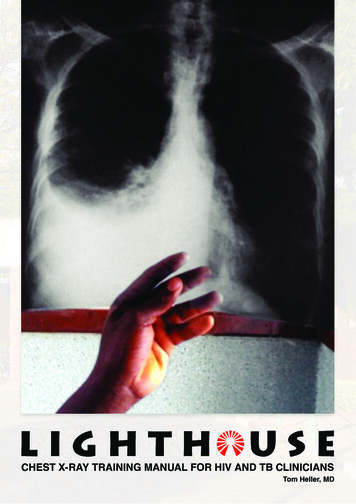
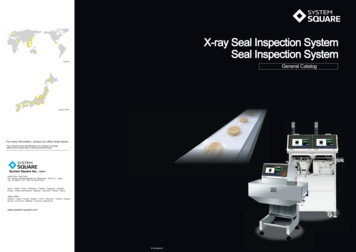
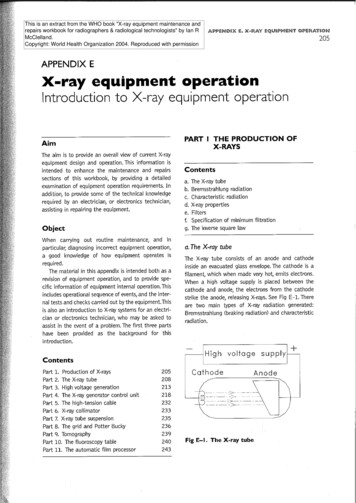
![[AWS Black Belt Online Seminar] AWS X-Ray](/img/17/20200526-blackbelt-x-ray.jpg)

